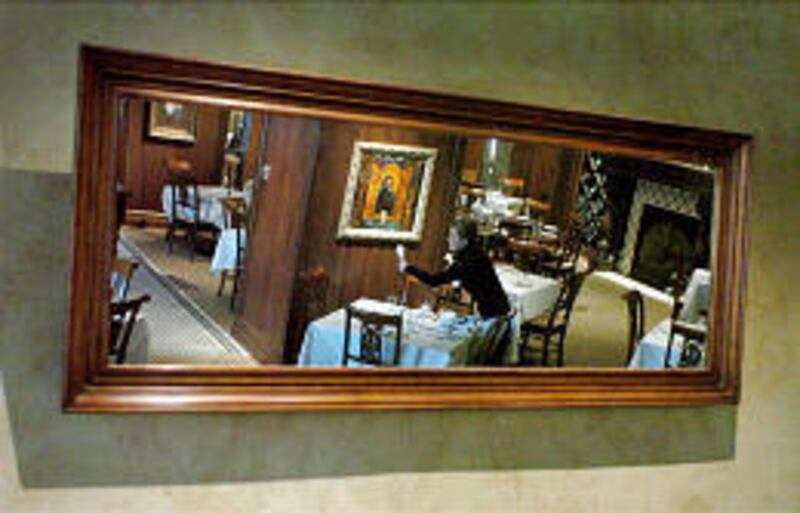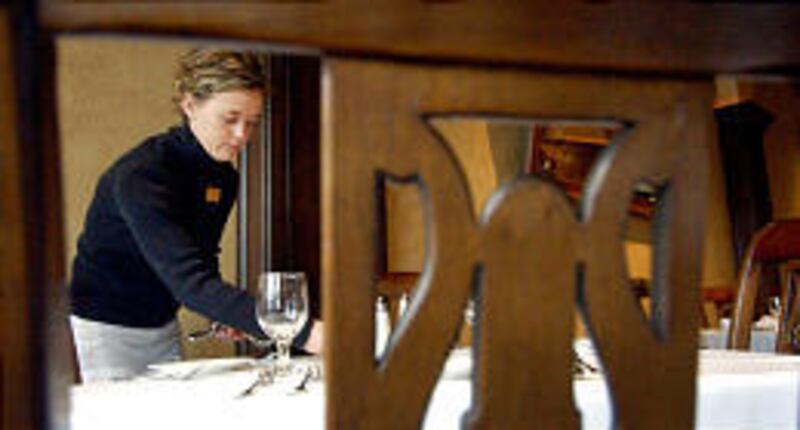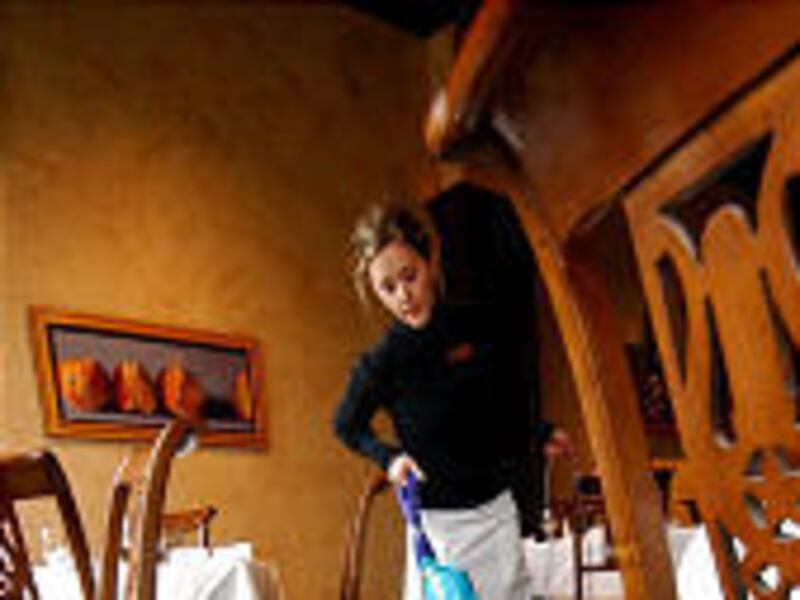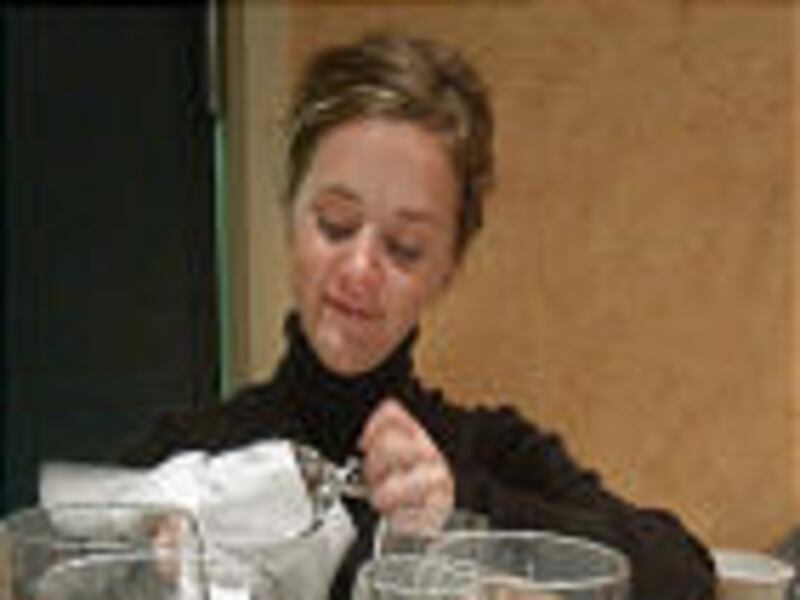Rats and bugs infesting restaurants. Sick employees handling food. Dirty pans and utensils used in preparation. Cold foods not kept cold enough, nor hot foods hot enough. Cooks who don't wash their hands. Serving contaminated food.
Those are some of what health inspectors consider "critical violations," or the infractions most likely to contribute to food-borne illness if not corrected quickly. Inspectors say that finding even one critical violation may be too many.
But Salt Lake Valley Health Department restaurant inspectors found a whopping 27,168 of them during 2003 and 2004 (plus another 67,135 lesser infractions).
 |
They found that number even though inspectors visit most food establishments only once or twice a year. They are admittedly too short-handed to inspect up to the four times a year that guidelines urge for some restaurant types.
Inspectors found an average of five critical violations every time they examined a full-service restaurant. At fast-food restaurants, they found an average of almost three. Other food-serving establishments, from nursing homes to bars, schools, theater snack bars and more, tended to average one or two critical violations each.
That's according to a computer-assisted analysis of electronic records for nearly 10,000 inspections during 2003 and 2004. The data were obtained by the Deseret Morning News through a state open records law request.
The analysis shows which restaurants had the most violations per inspection and the fewest, with 25 establishments averaging 13 or more critical violations per inspection, while 30 had perfect scores with no violations of any kind during the two years.
It shows which fast-food chains had the best and worst inspection scores (Starbucks had the best overall and Hogi Yogi the lowest). Reports also allowed comparisons among different types of ethnic food establishments. (Indian restaurants had the best scores, and Vietnamese the lowest.)
The health department does not routinely make such inspection data public, so few consumers are likely to have any idea of how clean — or dirty — the restaurants they visit are. In fact, even if residents report that a restaurant's food may have made them sick, the health department will not share results of investigations with them unless they file a formal request under the Government Records Access Management Act.
Even so, inspectors and industry spokesmen say the lion's share of restaurants do a good job, are safe and tend to quickly try to address any problems that inspectors find.
Serious violations?
Ron Lund, environmental health supervisor for the health department, says just one "critical violation" is serious— and may be too many.
"It depends on which critical violation it is," he said. Among those that are most serious and too common are "not washing hands, bare-hand contact with (ready to serve) food and ill employees who are at work."
But, he said, a few other "critical" violations do not pose as much immediate danger for health. "For example, it is a critical violation to fix plumbing with duct tape. Plumbing being repaired properly is considered critical but probably doesn't present a real food safety hazard. It's more of an operational hazard."
Morning News analysis shows that some of the most common violations of any type found in Salt Lake County are also some of the most critical and serious.
The most common violation of any type, cited 5,739 times over the two years, was the "critical" violation of using unclean equipment "such as pots and pans or utensils," Lund said.
Other often-cited "critical" violations include:
Failure to keep cold foods at temperatures below 41 degrees and hot foods hotter than 135 degrees. Such violations were found 4,111 times.
Improper segregation of stored foods. Lund said that includes such things as "storing raw meats over ready-to-eat foods or chicken over fish." It was found 1,988 times.
Storing toxic chemicals too near food, found 1,770 times.
Food handlers eating, drinking or smoking improperly around foods, cited 1,734 times.
Contamination of food by employee hands, found 1,067 times. (Ready-to-eat food can be touched only by utensils, or hands gloved or similarly protected, Lund said.)
Some other interesting but less common instances of critical violations include inspectors seeing food handlers fail to wash hands after using a restroom or at other required times, cited 638 times; not adequately controlling pests, 304 times; failure to discard contaminated food, cited 89 times; and sick people working around food even with discharges from their eyes, noses and mouths, cited seven times.
Lund notes these violations are just what inspectors observed personally during periodic visits.
Inspectors cited, at least once, a total of 81 different types of critical violations.
Melva Sine, president and CEO of the Utah Restaurant Association, says, however, that the number of violations found "are minuscule" when "you consider that over 2 million meals a day are served in restaurant facilities" in Utah, and 70 percent of them are served in Salt Lake County.
In fact, she says, studies show one-third of all meals eaten by Utahns are served by restaurants.
"Food safety is No. 1 for our restaurants," she said. Most do a good job. "Providing a great dining experience is what it is all about." She adds that years ago the industry initiated and supported legislation that led to restaurant inspections.
She said her association also offers classes in food safety management, and law requires that each restaurant have at least one certified food safety manager.
Multiple violations
Which restaurants had the most critical violations? Records show that at the top of that list, 26 restaurants had more than 13 critical violations per inspection. That is six times more than the median for all food establishments — just two violations. (See accompanying chart.)
The restaurant with the most violations per inspection was a now out-of-business Chevy's Fresh Mex restaurant, 358 S. 700 East, with 21.
Some well-known restaurants appear on the list of violators.
They include the Joseph Smith Memorial Building, 15 E. South Temple (with 15.5 critical violations per inspection); the Red Butte Cafe, 1414 S. Foothill Drive (14.5); Cafe Trang, 818 S. Main (14.7); and a Godfather's Pizza location at 4950 W. 6200 South (15).
Some of the other establishments with the most violations per inspection included Ogie's Cafe, 3515 S. Redwood Road (18.7); China Station, 1645 W. 7800 South (17.3); B&D Burgers, 222 S. 1300 East (17); the now-out-of-business New India Palace, 1241 E. 8600 South (16); and the now-out-of-business Beto's Tacos Don Chuy, 12580 S. Redwood Road (16).
Of note, that list includes mostly full-service restaurants or buffets with complicated menus, or food that must be kept at difficult-to-maintain temperatures. That does not surprise Lund.
"If they have a complex menu with a high volume of people and a complex system of operation, it's harder to run a tighter ship. Some do it very well, though," he said.
Records show that among all types of food establishments, full-service restaurants had the highest average of critical violations per inspection at five. Private club restaurants were close behind with 4.2; cafeterias/buffets had 2.9; retirement homes had 2.7; and fast-food restaurants had 2.6. (See accompanying chart.)
At the other end of the spectrum, establishments with the lowest number of critical violations per inspection tended to have simple menus or to be less busy. They included snow cone stands (0.4 critical violations per inspection); beverage-only sites (0.9); senior citizen centers (0.9); and food and drink carts (1.1).
Ultimate penalty: closure
The New India Palace and the Chinese Gourmet restaurant, 4425 S. State, made two lists they likely wanted to avoid: those with the most violations, and those ordered temporarily closed by inspectors to fix problems.
The Chinese Gourmet was closed by inspectors for just a few hours because its water had been turned off. But the New India Palace, which is now out of business, was closed for three days because of numerous violations that formed what inspectors said was "an imminent health threat."
Among "critical" violations noted at the New India Palace were two instances of reusing dirty pots or utensils; four of keeping foods at unsafe temperatures; one of contamination by employee hands; one for lack of proper hand-washing facilities; and two for improper storage and failure to separate foods as required.
Records show that inspectors ordered a total of 39 food establishments to close temporarily during 2003 and 2004 to fix serious problems. (See accompanying chart.)
They included an Arby's in Crossroads Plaza; a Carl's Jr. at 3535 W. 3500 South; Mi Ranchito, 2747 W. State; the New South Seas restaurant, 23 E. 2100 South; and Tokyo Grill, 140 S. Rio Grande.
Some were closed for less than a day. Others ended up closing permanently.
The most common reason listed for the closures was lack of an operational hand sink at mobile carts and trucks, which was verified 26 times.
"Every cart should have a hand sink that is operational so employees can wash hands after tasks like handling raw foods, or after they take a break. It's their way to remove bacteria and viruses from the hands," Lund said.
Lack of health department permits forced five closures; numerous critical violations that combined to form what inspectors considered an "imminent health hazard" brought four closures; sewage backups forced four closures; lack of refrigeration caused one and lack of water caused another.
Perfect scores
On the other end of the spectrum, 30 establishments were perfect in health inspections in 2003 and 2004 and were cited for no violations of any kind. (See accompanying list.)
"It's not easy to do," said Alicia Leonard, manager of the upscale Boulevard restaurant in Holladay, one of only two still-open, full-service restaurants that made that list.
"There is an emphasis on cleanliness every day, and every week or two we do a deep cleaning. We remove everything, clean behind it and put it back," she said. "It becomes a little tedious, but we do try to make sure the restaurant stays clean and pleasant for our patrons."
Others on the "perfect" list included a Pei Wei Asian Diner at 1028 E. 2100 South; a Figaro's Pizza at 824 W. North Temple; a Domino's Pizza at 7953 S. Airport Road in West Jordan; and the Dragon's Lair Pub, 3040 S. State.
Several school cafeterias had perfect records, including Fox Hill Elementary in Taylorsville; Jordan Valley School in Sandy; and Mountain View Elementary in Salt Lake City.
Ethnic, fast foods
The data collected also allows some comparison between types of ethnic restaurants. (See accompanying chart.)
Vietnamese restaurants, which tend to have large menus, had by far the most critical violations per inspection at 7.5.
Not too far behind were Chinese restaurants, with a median of 5.13.
Most of the rest were bunched closely together: Korean and Japanese (a median of four critical violations per inspection); Brazilian and Thai (tied at 3.67); Greek (3.58); British (3.5); French and Italian (tied at 3.33); Mexican and Mediterranean (tied at 3); and Indian (2.5).
The Morning News also compared median scores for local fast-food chains that had at least six different stores in Salt Lake County.
Starbuck's had the best score, with a median of 0.33 critical violations per site over the two years. Of course, it has much less cooking than many of the other fast-food chains.
Also with good scores were Papa John's Pizza (a median of 0.5 critical violations per inspection per site); Domino's Pizza (1); Wendy's (1.13); Sconecutter and Taco Bell (tied at 1.25); Blimpies (1.29); and 5 Buck Pizza (1.33).
Hogi Yogi had the worst score, a median of 6.75 critical violations per site per inspection.
Others just behind it on the list were Beto's Mexican Food (4.96); Crown Burger (3.88); Godfather's Pizza (3.5); Apollo Burgers (3.46); Arby's and Arctic Circle (tied at 3); and Iceberg Drive Inns (2.9).
Consequences
Lund says inspectors will immediately close any food establishment that they feel truly poses an immediate health risk. But, he said, they try to avoid that drastic step when possible, working in other ways to urge owners to fix problems.
"We find that most of the managers are willing to comply," Lund said. "Even on the list of closures, some of them may run a pretty good operation. . . . To reopen, they've had to do enough to show that it is safe to be open."
Besides closure, Lund said inspectors can order follow-up inspections when too many serious violations are found. The follow-up visits cost the owners $105 each. Inspectors also can order meetings to develop plans to alleviate problems. And if establishments have a history of poor scores, the health department may order inspections more often.
One tool the health department does not use is threats of bad publicity. In fact, it will not release any information about any inspection unless it is formally requested through GRAMA.
The health department does disclose on its Internet site when a food establishment has been ordered closed, but, Lund says, it leaves that listing online for no more than seven days. Officials will remove the notice within 24 hours of any reopening.
Lund said the department has considered putting more extensive data online, including comparing how certain types of similar establishments rank compared to each other. But that is only in the discussion stages. For now, the only place to see a tally of violations per restaurant is on the Morning News Web site.
Sine expresses mixed feelings about the health department considering putting more inspection data online. She said her group would not oppose it if people clamored for it but sees no such demand now.
But she also warns that inspections are subjective, and she hopes that any information that might be listed would be easy to understand, avoiding jargon that might unduly worry residents.
Sine also said her group views inspectors more as educators than punishment-givers or public whistle-blowers. "The inspection process is all about education and training," she said.
She notes that the industry has a yearly job turnover rate of 72 percent, so it faces huge hurdles in training workers about advances in food safety technology. Inspectors often are the ones who bring such news.
Short-handed
Analysis by the Morning News also showed that many restaurants have not been inspected as often as called for by health department guidelines. Officials say they are close to fixing that problem.
The number of suggested inspections varies according to how a restaurant is grouped into one of four "risk levels," determined by how many people they serve, what types of raw and cooked foods they handle and how complicated their cooking processes are.
Guidelines call for the highest-risk group, called Risk 4, to be inspected every three months. The next lowest group, Risk 3, is supposed to be inspected every six months. Those in Risk 2 are supposed to be inspected once every nine months. And those in Risk 1 are supposed to be inspected once every 12 months.
Lund said, for example, that 346 full-service restaurants are in the Risk 4 category that should be inspected four times a year. The data showed, however, that a mere 13 full-service restaurants had been inspected that often in 2003, and only 17 in 2004.
The News also found that just under half of all full-service restaurants (all in either Risk 4 or Risk 3) were inspected at least two times in 2003, which improved in 2004 to more than 60 percent. But that meant that two of every five still were not inspected at least two times a year, the minimum suggested by guidelines.
For fast-food restaurants, the News found that only about a third had been inspected two or more times in 2003, but that improved to nearly 45 percent in 2004.
Dozens of restaurants in the database had been inspected in one year but not the other. While much of that was because of restaurants going out of business or starting up, some examples were found of restaurants that clearly had continued in business through both years but had not been inspected in both.
Lund acknowledged that the health department has been unable to inspect as often as called for by guidelines but said that is changing.
"The Bureau of Food Protection has been understaffed for the past several years due to retirements, promotions, transfers and career changes. In November of 2004, the bureau became fully staffed," he said.
He said seven people were hired last year, and each required significant time for training. However, he said, "The bureau has in 2003 and 2004 increased the number of inspections. . . . Increased productivity by inspectors in recent months has put us closer to meeting the inspection intervals outlined by the risk levels."
He said the bureau has the equivalent of 17 full-time inspectors. (It has 38 people who do inspections, but many also do work for other arms of the health department.)
Final word
Lund, who makes a living looking for problems at restaurants, says he still enjoys eating out. He may give some courage, or solace, to those who may hesitate after seeing the numbers of violations.
"I eat out. It doesn't discourage me. I even eat at some places that, well, aren't as good (in scores) as others," he says.
He offers some advice: Go where you enjoy the food and look around to see if it looks clean and well-operated. He concedes that even though he enjoys eating out, "There are places where I don't want to eat anymore" because of too-low scores for too long.
Sine, with the restaurant association, also urges residents not to worry and to enjoy eating out. "When you consider the number of meals served and the number of violations . . . the restaurant industry does an excellent job."
She said: "Enjoy eating out. There are many places to eat, and they fit every budget. It is a great way to get out of the house and do something with the family."
E-mail: lee@desnews.com




